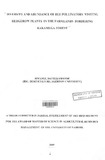| dc.description.abstract | The study was carried out in Kakamega farmland, north of the Kakamega forest, from October
2008 to March 2009, in order to determine the diversity and abundance of bee pollinators that
forage on flowers in the hedgerows, and the major bee plant species. Fourty hedgerow transects
measuring 50m each were selected and marked in the farmland. Five land use categories i.e,
forest, roads, sugarcane, grazing and maize/beans production were used as a criteria for
transect selection, hedgerow plant composition was also considered. Each of the transect was
sampled twice a month for the bees visiting the flowers from October 2008 to March 2009.
During sampling all the bees foraging on the flowers of the plants in the hedgerow were
recorded, together with the plant species visited. Each sampling took 40 minutes. All the bees
that could not be identified on site were captured using standard sweepnets, kept in killing jars
and labelled with a code. Later the bees were pined in the insect pinning boxes for
identification at the NMK. Similarly, specimen of the plants that could not be identified were
collected and labelled with similar codes for further identification. The results indicate a
significant variation both in bee diversity and abundance across the five land uses. A total of 82
bee species belonging to three families, i.e. Apidae, Megachilidae and Halictidae were recorded
on hedgerow flowers. Apidae was the most diverse family having 42 bee species with Apis
mellifera being the most frequent visitor. The megachilidae and halictidae families had 20
species each. Xylocopa species mostly visited Justicia jlava, Caesalpinia decapetala and
solanum incanum plants while most Meliponula species visited Tithonia diversifolia
flowers. The plant species/family in the hedges had significant variation both in the number of
bee species (diversity) and individuals (abundance) for all the bees except Megachilidae. The
most important bee resource plants in the hedgerows based on the number of indviduals that | en |

